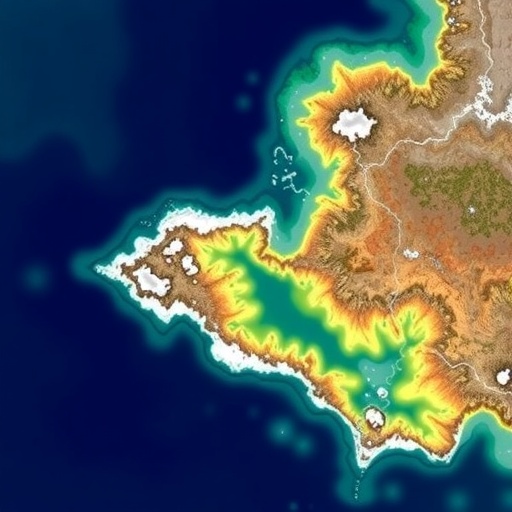A groundbreaking advancement in our understanding of coastal systems has emerged from the research team led by Zhaoyuan Yu and Linwang Yuan at Nanjing Normal University. Their pioneering work, recently published in Science China Earth Sciences, introduces a unified mathematical framework that fundamentally redefines how coastal tipping points are conceptualized, described, and classified. This paradigm-shifting model addresses an urgent global challenge: safeguarding vulnerable coastal zones amid escalating pressures from climate change and intensified human activity.
Coastal regions represent some of Earth’s most dynamic and ecologically rich interfaces, integrating land, sea, and human elements. These zones host a myriad of ecosystems including wetlands, estuaries, and coral reefs, which provide critical services ranging from biodiversity support to storm protection. However, such systems are increasingly at risk due to rising sea levels, accelerating shoreline erosion, and widespread habitat degradation. These disturbances threaten to push coastal environments past critical thresholds—tipping points—beyond which abrupt, and potentially irreversible, ecological and geomorphological changes occur.
The newly developed model by Yu and colleagues employs the rigorous language of dynamical systems theory, embedding sophisticated representations of spatiotemporal diffusion tensors and interaction fluxes to accurately capture the complex coupling of land-sea interfaces. This approach integrates physical, ecological, and social subsystems into a coherent mathematical construct that allows for precise depictions of nonlinearities, thresholds, and hysteresis effects inherent to coastal dynamics. Such a framework is vital for predicting the conditions under which small perturbations may trigger disproportionately large regime shifts.
One of the hallmark contributions of this research is the categorization of coastal tipping points into six distinct types, each with unique driving mechanisms and characteristics. First, bifurcation-driven tipping points arise from gradual shifts in system parameters that destabilize existing equilibria, leading to potentially sudden transitions. Noise-driven tipping points emerge from random fluctuations or disturbances that amplify system vulnerabilities. Shock-driven tipping points result from acute, extreme events such as storms or tsunamis exerting overwhelming stress.
Further enriching the typology, rate-driven tipping points occur when the pace of external forcing exceeds the adaptive capacity of the coastal system, preventing smooth transitions and provoking instability. Space-driven tipping points stem from spatial heterogeneity and landscape patchiness, where localized changes propagate as cascading effects, altering system-wide states. Lastly, information-driven tipping points involve delays or failures in response linked to knowledge gaps, miscommunication, or inadequate governance, highlighting the critical role of human decisions in coastal resilience.
To validate and contextualize their theoretical model, the research team harnessed large language model-based text mining techniques to analyze an extensive dataset comprising 91 documented global coastal tipping cases. This meta-analytical approach revealed that such tipping phenomena are both pervasive and heterogeneously distributed, with pronounced hotspots often coinciding with densely populated urban coastal zones or ecologically sensitive regions. This spatial disparity underscores the complex interplay between natural processes and anthropogenic influences.
The implications of this study are profound for coastal management and policy-making. By establishing a robust, unified framework, the researchers provide not only predictive capabilities regarding when and where tipping points may occur but also a taxonomy to differentiate their causal dynamics. Such distinctions are crucial for tailoring response strategies—whether they involve enhancing adaptive capacities to gradual change or preparing rapid interventions for shock events.
This integrated perspective calls for a “classification-identification-response” strategy that synthesizes comprehensive data gathering, real-time monitoring, and adaptive governance practices. The model accentuates the necessity of cross-disciplinary collaboration between climatologists, ecologists, sociologists, and decision-makers to effectively anticipate tipping points and mitigate their impacts. It also highlights the vital role of improved data integration technologies and communication channels to prevent information-driven failures.
Furthermore, the mathematical rigor applied in this research lays a foundation for future computational and simulation studies, enabling scenario testing under diverse environmental and socio-economic conditions. Such predictive modeling can inform targeted conservation efforts, infrastructural planning, and disaster preparedness initiatives designed to buffer coastal communities and ecosystems from regime shifts.
In a broader scientific context, this work bridges the conceptual gap between global climate tipping points and highly localized coastal phenomena, revealing how regional heterogeneity and coupled subsystem interactions create unique vulnerability profiles. By capturing these nuances, the model advances the frontier in Earth system science, providing a scalable framework adaptable to other complex, coupled natural-human systems.
Ultimately, the unified description and classification model crafted by Yu, Yuan, and their team marks a watershed moment in coastal science. It equips researchers and policymakers with unprecedented tools to detect early warning signals, elucidate tipping mechanisms, and implement proactive strategies that can safeguard our planet’s invaluable coastal interfaces from escalating environmental threats. This leap forward in understanding moves us closer to balancing human development and ecological preservation amid accelerating global change.
Subject of Research: Unified mathematical modeling and typology classification of coastal tipping points under coupled physical, ecological, and social dynamics.
Article Title: Unified description model and typology classification of coastal tipping points
News Publication Date: 2025
Web References: http://dx.doi.org/10.1007/s11430-025-1698-8
References:
Yu Z, Liang Z, Wang J, Liu Z, Du P, Zhao B, Yuan L. 2025. Unified description model and typology classification of coastal tipping points. Science China Earth Sciences, 68(11): 3482–3494.
Image Credits: ©Science China Press
Keywords: Coastal tipping points, dynamical systems theory, bifurcation, noise-driven tipping, shock-driven tipping, rate-driven tipping, space-driven tipping, information-driven tipping, land-sea coupling, nonlinear thresholds, hysteresis, adaptive governance, climate change impacts




